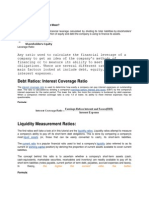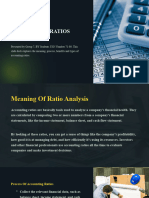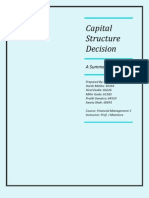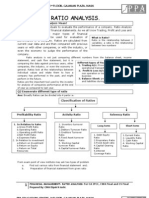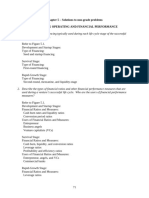Y Y Y Y Y Y Y Yyyyyyyyyyy Y YYY
Y Y Y Y Y Y Y Yyyyyyyyyyy Y YYY
Uploaded by
Bailappa HulurkarCopyright:
Available Formats
Y Y Y Y Y Y Y Yyyyyyyyyyy Y YYY
Y Y Y Y Y Y Y Yyyyyyyyyyy Y YYY
Uploaded by
Bailappa HulurkarOriginal Title
Copyright
Available Formats
Share this document
Did you find this document useful?
Is this content inappropriate?
Copyright:
Available Formats
Y Y Y Y Y Y Y Yyyyyyyyyyy Y YYY
Y Y Y Y Y Y Y Yyyyyyyyyyy Y YYY
Uploaded by
Bailappa HulurkarCopyright:
Available Formats
Capital Structure details of Axis Bank (Rs in Crores)
Particulars Owners Fund Equity share capital Share application money Reserves & surplus Loan Funds Secured loans Unsecured loans Total
Mar-2008
Mar-2009
Mar-2010
357.71 2.19 410.79
359.01 1.21 854.58 8
405.17 0.17 15,639.27 9
87,626.22 96,396.91
1,17,374.11 1,41,300.22 27,588.90 1,57,344.84 1,
Capital Structure details of HDFC Bank (Rs in Crores)
Particulars Owners Fund Equity share capital Share application money Reserves & surplus Loan Funds
Mar-2008
Mar-2009
Mar-2010
354.43 11,142.80
425.38 400.92 14,226.43
457.74 21,064.75
Secured loans Unsecured loans Total Capital Structure details of ICICI Bank
1,00,768.60 1,12,265.83
1,42,811.58 1,67,404.44 1,57,864.31 1,88,926.93
(Rs in Crores)
Particulars Owners Fund Equity share capital Preference Share Capital Share application money Reserves & surplus Loan Funds Secured loans Unsecured loans Total
Mar-2008
Mar-2009
Mar-2010
1,112.68 350.00 45,357.53
1,113.29 350.00 48,419.73
1,114.89 50,503.48
2,44,431.05 2,91,251.26
2,18,347.82 2,02,016.60 2,68,230.84 2,53,634.96
Ratio Analysis Liquidity Ratios Investor look at liquidity ratios to determine the ability of a business to pay off its short term obligations from cash or near cash assets to evaluate the risk associated if were to invest in this company. Failure to pay off short term obligation may result in financial difficulty or bankruptcy in near future. Liquidity ratios help investors to minimize the risk in stock market investment to screen out financial sound companies on stock pick to build up their "buy and hold" portfolio. a) Cash Ratio Cash ratio measure the ability of a business to meet short term obligations. It measures to the extent which current obligation can be paid from cash or near cash assets. Formula: Cash Ratio = (Cash and Cash equivalents) / Current Liabilities y y y Cash Ratio <= 1 Dangerous Zone. Very low liquidity. 1 < Cash Ratio- Short term debt can be paid in full with cash and near cash items. 2 < Cash Ratio- Bad management of short term liquidity, Cash could be invested in longer term assets earning a higher return.
b) Quick Ratio Quick ratio also known as Liquidity Ratio or Acid Test, it measures the ability of a company to pay off its short-term obligations from current assets, excluding inventories. The reason of excluding inventories is due to its low liquidity and thus quick ratio provide better measurement of company ability to paid off it current obligations compare to current ratio. Quick ratio does not apply to companies with inventory is easily converted into cash, use current ratio instead.
Formula: Quick ratio = (Current Assets - inventory) / Current Liabilities y y y <= 1 Dangerous Zone, very low liquidity. 1 < Quick Ratio <= 2- May fail to meet short term obligations. 2 < Quick Ratio <= 5- Normal, depending on the industry standards for companies of similar size and activity. y 5 < Quick Ratio- Very little short term debt!
c) Current Ratio Current ratio measures the company's ability to pay its short-term liabilities from shortterm assets. Formula:
Current ratio = Current Assets / Current Liabilities
y y y
<= 1 Going bankrupt 1 < Current Ratio <= 2 May experience difficulties in facing short term obligations. 2 < Current Ratio <= 5 Normal, depending on the industry standards for companies of similar size and activity.
5 < Current Ratio Very little short term debt.
Leverage Ratio By using a combination of assets, debt, equity, and interest payments, leverage ratios are used to understand a company's ability to meet it long term financial obligations. The three most widely used leverage ratios are the debt ratio, debt to equity ratio, and interest coverage ratio. a) Debt Ratio The debt ratio gives an indication of a companys total liabilities in relation to their total assets. The higher the ratio, the more leverage the company is using and the more risk it is assuming. Both total assets and liabilities can be found on the balance sheet. There is a nuance to be aware of with this formula. Mentioned above, these leverage ratios are meant to measure long term ability to meet financial obligations. Well, when we take a
look at our Total liabilities number in more detail, items such as accounts payable are included. This is a short term liability which is essential for the proper functioning of the business and not a liability in the sense that we are discussing it here. Formula: Debt Ratio= Total Debt/ Total Assets
b) Debt to Equity Ratio The debt to equity ratio is the most popular leverage ratio and it provides detail around the amount of leverage (liabilities assumed) that a company has in relation to the monies provided by shareholders. As you can see through the formula below, the lower the number, the less leverage that a company is using. Again, like the debt ratio, we must understand the drawbacks of this formula. Total liabilities include operational liabilities that are required to run the business. These are not long term in nature and can distort the debt to equity ratio. Some will exclude accounts payable from the liabilities and/or intangible assets from the shareholder equity component.
Formula: Debt to Equity Ratio= Total Debts/ Total Equity
c) Interest Coverage Ratio The interest coverage ratio tells us how easily a company is able to pay interest expenses associated to the debt they currently have. The ratio is designed to understand the amount of interest due as a function of a companys earnings before interest and taxes (EBIT). Some will actually replace EBIT with EBITDA. It is different for each sector, but an interest coverage ratio below 2 may pose a threat to the ability of a company to fulfill its interest obligations. The interest coverage ratio is very closely monitored because it is viewed as the last line of defense in a sense. A company can get by even when it is in a serious financial bind if it can pay its interest obligations.
Formula:
Interest Coverage Ratio= EBIT/ Interest Expenses
You might also like
- Fin & Acc For MGT - Interpretation of Accounts HandoutNo ratings yetFin & Acc For MGT - Interpretation of Accounts Handout16 pages
- C 3 A F S: Hapter Nalysis of Inancial TatementsNo ratings yetC 3 A F S: Hapter Nalysis of Inancial Tatements27 pages
- REVIEWER Chapter 3 Analysis of Financial StatementsNo ratings yetREVIEWER Chapter 3 Analysis of Financial Statements7 pages
- ADL 03 Accounting For Managers V3final PDFNo ratings yetADL 03 Accounting For Managers V3final PDF22 pages
- Financial Analysis of Tata Motors: Submitted by Binni.M Semester-2 Mba-Ib ROLL - No-6100% (1)Financial Analysis of Tata Motors: Submitted by Binni.M Semester-2 Mba-Ib ROLL - No-619 pages
- Financial Feasibility: A) Current Ratio:-Current Assets Current LiabilitiesNo ratings yetFinancial Feasibility: A) Current Ratio:-Current Assets Current Liabilities5 pages
- Ratios Used in Credit Analysis: August 10, 2012No ratings yetRatios Used in Credit Analysis: August 10, 20123 pages
- Liquidity Ratios:: Current Ratio: It Is Used To Test A Company's LiquidityNo ratings yetLiquidity Ratios:: Current Ratio: It Is Used To Test A Company's Liquidity12 pages
- Chapter 3: Ratio Analysis.: ST ST ST STNo ratings yetChapter 3: Ratio Analysis.: ST ST ST ST36 pages
- Financial Analysis of Idea: Case Studies in Telecom BusinessNo ratings yetFinancial Analysis of Idea: Case Studies in Telecom Business8 pages
- Ncert Solutions For Class 12 Accountancy 23 May Chapter 5 Accounting RatiosNo ratings yetNcert Solutions For Class 12 Accountancy 23 May Chapter 5 Accounting Ratios40 pages
- Income Statements:: Financial Statement AnalysisNo ratings yetIncome Statements:: Financial Statement Analysis11 pages
- Income Statements:: Financial Statement AnalysisNo ratings yetIncome Statements:: Financial Statement Analysis11 pages
- Chap. 5 - Solutions To Non Graded Problems Week 2No ratings yetChap. 5 - Solutions To Non Graded Problems Week 212 pages
- Financially Yours Induction 2023 Study MaterialNo ratings yetFinancially Yours Induction 2023 Study Material12 pages
- Results and Analysis: 1) Current Ratio 2) Quick Ratio or Acid Test 3) Cash RatioNo ratings yetResults and Analysis: 1) Current Ratio 2) Quick Ratio or Acid Test 3) Cash Ratio51 pages
- Textbook of Urgent Care Management: Chapter 46, Urgent Care Center FinancingFrom EverandTextbook of Urgent Care Management: Chapter 46, Urgent Care Center FinancingNo ratings yet
- Fin & Acc For MGT - Interpretation of Accounts HandoutFin & Acc For MGT - Interpretation of Accounts Handout
- REVIEWER Chapter 3 Analysis of Financial StatementsREVIEWER Chapter 3 Analysis of Financial Statements
- Financial Analysis of Tata Motors: Submitted by Binni.M Semester-2 Mba-Ib ROLL - No-6Financial Analysis of Tata Motors: Submitted by Binni.M Semester-2 Mba-Ib ROLL - No-6
- Financial Feasibility: A) Current Ratio:-Current Assets Current LiabilitiesFinancial Feasibility: A) Current Ratio:-Current Assets Current Liabilities
- Liquidity Ratios:: Current Ratio: It Is Used To Test A Company's LiquidityLiquidity Ratios:: Current Ratio: It Is Used To Test A Company's Liquidity
- Financial Analysis of Idea: Case Studies in Telecom BusinessFinancial Analysis of Idea: Case Studies in Telecom Business
- Ncert Solutions For Class 12 Accountancy 23 May Chapter 5 Accounting RatiosNcert Solutions For Class 12 Accountancy 23 May Chapter 5 Accounting Ratios
- Results and Analysis: 1) Current Ratio 2) Quick Ratio or Acid Test 3) Cash RatioResults and Analysis: 1) Current Ratio 2) Quick Ratio or Acid Test 3) Cash Ratio
- Textbook of Urgent Care Management: Chapter 46, Urgent Care Center FinancingFrom EverandTextbook of Urgent Care Management: Chapter 46, Urgent Care Center Financing
- Summary of Richard A. Lambert's Financial Literacy for ManagersFrom EverandSummary of Richard A. Lambert's Financial Literacy for Managers











